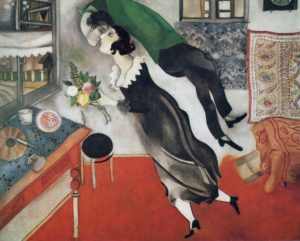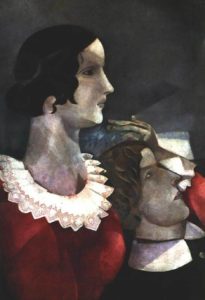
We’re so accustomed to pigeonholing artists into one school or another that when we encounter an artist like Marc Chagall, he seems almost like a misfit. Just what is this strange and charming combination of cubism and Russian folk art, of fairy tales and surrealism, of Jewish mysticism and fauvism?
Chagall was an artist who was determined to be himself, purely and simply, and yet in the process remained open to an incredible range of influences. A new show at the Jewish Museum, focusing on the first decade of Chagall’s career – 1907 to 1917 – gives us a vivid sense of all the different strands that were eventually woven together into Chagall’s unique sensibility.
As can be seen from the 100 or so paintings and drawings, these early years may have been Chagall’s best. Although he enjoyed worldwide fame for much of this century (he died, at age 98, in 1985), the signature-style work of his maturity never had the excitement and intensity of the years when he was still inventing himself.
What’s wonderful about Chagall is the way he breaks down barriers between traditions. When Chagall floated people over the tops of buildings, removed their heads, made giant cows and soaring fiddlers, he had the license both from surrealism and from the mystical fervor of his Hasidic upbringing.
His religious background explains the intensity he brought to paintings like “Adam and Eve,” in which Eve is shown literally emerging from Adam’s side – but at the same time the painting shows the influence of Matisse and the surrealist poets. When Chagall explained the genesis of a painting like “The Dead Man” (1908) – telling how, after a man died at dawn in the street of his native Vitebsk, the people put candles around him and began to pray while he still lay on the ground – the painting does not look nearly as surreal as we initially thought. Some of it really happened that way.

From this show, we also learn that Chagall’s career didn’t follow the usual trajectory of the provincial artist who comes to Paris, learns all the avant-garde styles, and never looks back. In the first place, Chagall got his introduction to modernism in St. Petersburg, where he was exposed to expressionism, Van Gogh, and the Fauves. He seems to have embraced these modern styles immediately and fearlessly. Then came four years in Paris (1910-1914), in which he took just enough from cubism to give his paintings a modern sense of space, but stopped well short of abstraction.
Then came the strangest episode of his career. He went home for what he thought was a brief visit in 1914. But World War I broke out and Chagall couldn’t leave, and his visit to Vitebsk stretched into several years. He made the most of this time, drawing poetry and beauty out of hat he saw around him, like the drab street corners in the gray and moody canvas titled, “The Moscow Bank in Vitebsk” (1914), and the touching portrait, “The Village Idiot.”
Chagall’s love affair with his young bride, Bela, figures largely in this exhibit, and shows the artist’s narcissistic side. It’s hard to say sometimes which of them is prettier: Chagall with his almond-shaped eyes and high cheekbones, or Bela, with her dark, dark eyes and smooth white complexion. The famous “Birthday” of 1915, with the artist flying through the room and twisting his head backwards to deliver a kiss, is the most famous of these. More revealing, perhaps, is the “The Lovers in Gray,” in which a dreamy and almost effeminate Chagall rests his head on the bosom of the strong, powerful-looking Bela.
The image of the dislocated head appears again and again. In “Drunkard,” the sideways-tilting head represents inebriation. In “Introduction,” it’s shyness, as the self-conscious artist hides his head behind his arm. Other times, as in “To Russia, to the Asses and Others” (1911), the head floating up in the clouds suggests dreaminess or artistic inspiration.
Some of the most beautiful paintings in this show are the small watercolors and gouaches, like “Water Carrier under the Moon, 1912,” in which Chagall shows us why he is considered one of the century’s most gifted colorists. But the overriding impression this show gives is how Chagall was able to maintain his deep attachment to his Russian-Jewish heritage, and to use it as fuel for a daring, modernist adventure

